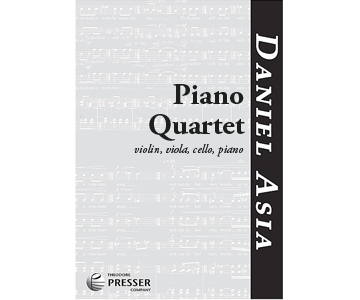Scoring
violin, viola, cello, piano
Duration 25 Minutes
Movements
1. Tranquillo
2. Adagio/Allegro
3. Dancelike
Recording
Album Title
Daniel Asia: Ivory
Label
Summit Records [product id: DCD286]
Sound File
Adagio/Allegro
Commissioned by
the Koussevitsky Foundation
Performances
NOVEMBER 1991
INDIANAPOLIS, IN
AMERICAN PREMIERE
Scott Chamber Players
Indianapolis Museum of Art
Indianapolis, IN
SATURDAY, SEPTEMBER 30, 1989
LONDON, ENGLAND
Domus Piano Quartet
Wigmore Hall
London, England
Program Notes
Piano Quartet is a work in three movements. Each has its own distinct shape, materials, and atmosphere, yet various motives, as well as textural ideas, create interlocking relationships between the movements.
The first movement, which is marked “moderately”, is lyrical, yet sedate, and incantatory in mood. Its structure is formed from the simple alternation of two basic materials. The first is improvisatory in character, the second a simple melody that is accompanied by repeated motives and a countermelody. On repetition of these sections the parts are exchanged between the various instruments. A brief coda brings the movement to a close.
The second movement develops motivic ideas found in the first and the last movements, and presents and develops its own range of new materials. By its placement, duration (it is the longest of the three movements), and range of materials, it is the centerpiece of the work. Tempi range from slow to very quick. Whereas in the outer movements the full ensemble is frequently heard in unified textures, here the strings and piano are often presented as antagonists in the musical drama. Only in climactic sections is a unity of statement and resolution expressed by all instruments joining in the same gestures.
The third movement is almost a dance in quick tempo. One hears the presence of verse and refrain structure, with the melody emanating from the viola. Eighth-notes are almost always present, and the sound is bright. The work is brought to a close with the motive that has appeared in various guises in all of the movements.
Reviews
J. SUTHERLAND, THE SEATTLE TIMES
The three-movement piece is a wonder of textures, mixing fingered and open-string timbres with extensive use of string harmonics.
P. KIRALY, SEATTLE POST-INTELLIGENCER
It’s a beautifully constructed, substantive work with supported lyrical melodies wrapped in light, airy fragments.
